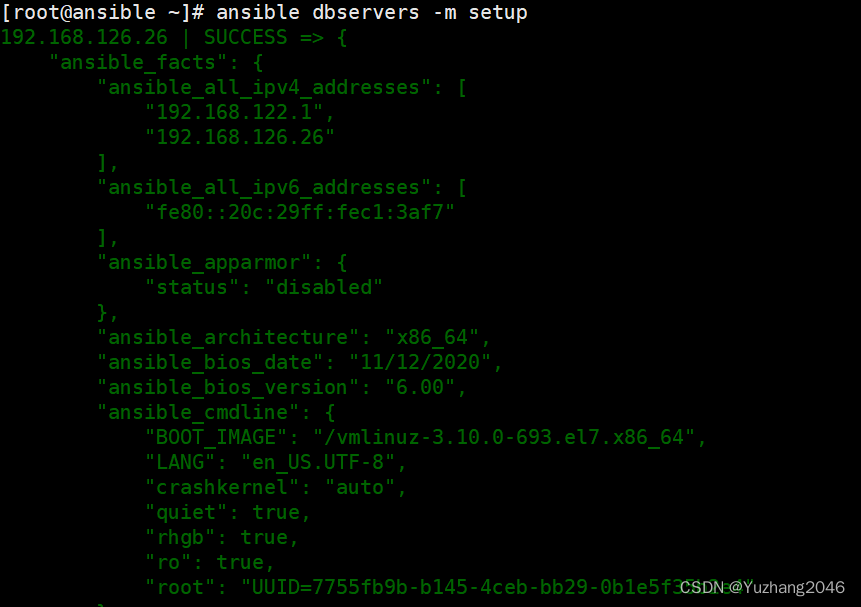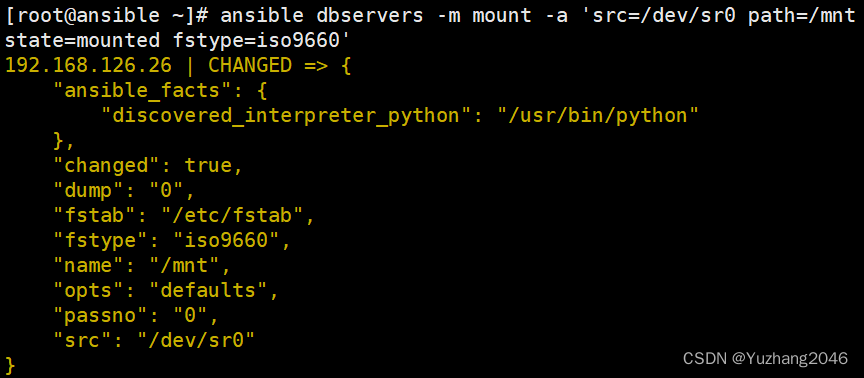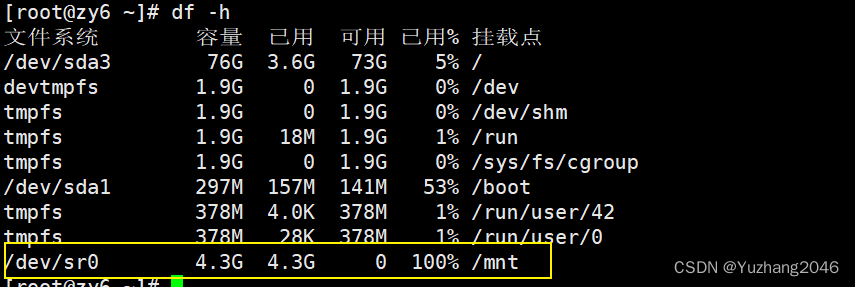一、Ansible概述
1.1 Ansible是什么
Ansible是一个基于Python开发的配置管理和应用部署工具,现在也在自动化管理领域大放异彩。它融合了众多老牌运维工具的优点,Pubbet和Saltstack能实现的功能,Ansible基本上都可以实现。
Ansible能批量配置、部署、管理上千台主机。比如以前需要切换到每个主机上执行的一或多 个操作,使用Ansible只需在固定的一台Ansible控制节点上去完成所有主机的操住。
Ansible是基于模块工作的,它只是提供了一-种运行框架,它本身没有完成任务的能力,真正执行操作的是Ansible的模块,比如copy模块用于拷贝文件到远程主机上,service模块用于管理服务的启动、停止、重启等。
1.2 Ansible的四个组件:
- Inventory 主机清单(主机组)
- Modules 模块
- Plugins 插件
- Playbooks 剧本(相当于脚本)

1.3 Ansible的特性
(1)特性一:
Ansible其中一个比较鲜明的特性Agentless,即无Agent的存在(无代理端,即无客户端),它就像普通命令一样, 并非c/s软件,也只需在某个作为控制节点的主机上安装一次Ansible即可,通常它基于ssh连接来控制远程主机,远程主机上不需要安装Ansible或其它额外的服务。
使用者在使用时,在服务器终端输入命令或者playbooks,会通过预定好的规则将playbook拆解为play(一个play就是一个Linux操作),再组织成ansible可以识别的任务,调用模块和插件,根据主机清单通过SSH将临时文件发给远程的客户端执行并返回结果,执行结束后自动删除。
(2)特性二:
Ansible的另一个比较鲜明的特性是它的绝大多数模块都具备幂等性(idempotence)。所谓幂等性,指的是多次操作或多次执行对系统资源的影响是一致的。
比如执行 systemctl stop xxx 命令来停止服务,当发现要停止的目标服务已经处于停止状态,它什么也不会做,所以多次停止的结果仍然是停止,不会改变结果,它是幂等的,而systemctl restart xxx是非幂等的。
Ansible的很多模块在执行时都会先判断目标节点是否要执行任务,所以,可以放心大胆地让Ansible去执行任务,重复执行某个任务绝大多数时候不会产生任何副作用。
二、Ansible 环境安装部署
实验环境:
| 角色 | IP | 安装工具 |
|---|---|---|
| 管理端 | 192.168.126.27 | ansible |
| 被管理端 | 192.168.126.28 | 无需安装 |
| 被管理端 | 192.168.126.29 | 无需安装 |
| 被管理端 | 192.168.126.26 | 无需安装 |
安装部署:
hostnamectl set-hostname ansible #iptables默认放通ssh 所以不用关闭防火墙
#1、管理端安装ansible
yum install -y epel-release #先安装epel源
yum install -y ansible #安装ansible
#ansible目录结构
[root@ansible ~]# cd /etc/ansible
[root@ansible ansible]# tree
.
├── ansible.cfg
├── hosts
└── roles
1 directory, 2 files
#2、配置主机清单,修改/etc/ansible/hosts文件
cd /etc/ansible
vim hosts
[webservers] #配置组名
192.168.126.28 #组里包含被管理的主机IP或主机名(主机名需要先修改/etc/hosts文件)
192.168.126.29
[dbservers] #第二个组
192.168.126.26
#3、ansible默认使用ssh连接,所以管理前要设置免密登录
#配置密钥对验证
ssh-keygen -t rsa #一路回车,生成密钥文件
vim /etc/ssh/ssh_config #修改ssh客户端配置文件
StrictHostKeyChecking no #35行,取消注释,将ask修改为no,开启免交互
systemctl restart sshd #重启sshd
#使用sshpass,以免交互的方式将公钥文件传给被管理端,实现免密登录
sshpass -p '123456' ssh-copy-id root@192.168.126.28
sshpass -p '123456' ssh-copy-id root@192.168.126.29
sshpass -p '123456' ssh-copy-id root@192.168.126.26
#如果被管理端主机有很多台,可以通过sshpass和for循环写一个脚本,实现多台主机免密登录。
三、ansible常用的命令行模块
ansible管理命令:
ansible <组名> -m <模块> -a <参数列表>
ansible <主机IP> -m <模块> -a <参数列表>
ansible <主机名> -a <参数列表> #不加-m指定模块默认使用command
#选项解释
-m: 指定模块
-a: 指定命令
查看ansible的模块:
ansible-doc -l #列出所有已安装的模块,按q退出
ansible-doc -l | wc -l #统计总共有多少模块
3387
ansible-doc -s 模块 #查看指定模块的描述信息和操作动作3.1 command模块
在远程主机执行命令,不支持管道、重定向等shell的特性。
ansible-doc -s command #-s列出指定模块的描述信息和操作动作
#指定ip执行date
ansible 192.168.126.28 -m command -a 'date' #-a指定命令
#指定组执行date命令
ansible webservers -m command -a 'date' #指定webservers组执行date命令
ansible dbservers -m command -a' date' #指定dbservers组执行date命令
ansible all -m command -a ' date' #all代表所有hosts 主机
ansible all -a 'date' #如省略-m模块,则默认运行command 模块
##常用的参数:
chdir:在远程主机上运行命令前提前进入目录
creates:判断指定文件是否存在,如果存在,不执行后面的操作
removes:判断指定文件是否存在,如果存在,执行后面的操作
#无论管理端当前在哪个目录,执行命令都是在被管理端的家目录进行操作,可以使用chdir参数先切换目录
ansible dbservers -m command -a "chdir=/home ls ./" #切换到/home目录下再执行命令
#creates判断目标主机的指定是否存在,如果存在,则不执行后面的操作
ansible dbservers -m command -a "creates=/data/f1.txt date"
ansible dbservers -m command -a "creates=/data/aa.txt date"
#removes判断目标主机的指定是否存在,如果存在,执行后面的操作
ansible dbservers -m command -a "removes=/data/f1.txt date"
ansible dbservers -m command -a "removes=/data/aa.txt date"
常用参数示例:
(1)chdir
在远程主机上运行命令前提前进入目录。
#无论管理端当前在哪个目录,执行命令都是在被管理端的家目录进行操作,可以使用chdir参数切换目录。
#目标主机切换到/home/目录后,再执行命令
[root@ansible ~]# ansible dbservers -m command -a "chdir=/home ls ./"
192.168.126.26 | CHANGED | rc=0 >>
zy006
#目标主机切换到/opt/目录后,再执行命令
[root@ansible ~]# ansible dbservers -m command -a "chdir=/opt ls ./"
192.168.126.26 | CHANGED | rc=0 >>
rh
(2)creates
判断指定文件是否存在,如果不存在,则执行后面的操作。
#creates判断目标主机的指定文件是否存在,因为不存在,所以执行后面的命令
[root@ansible ~]# ansible dbservers -m command -a 'creates=/opt/f1.txt touch /opt/f1.txt'
[WARNING]: Consider using the file module with state=touch rather than running
'touch'. If you need to use command because file is insufficient you can add
'warn: false' to this command task or set 'command_warnings=False' in
ansible.cfg to get rid of this message.
192.168.126.26 | CHANGED | rc=0 >>
#在dbservers 设定的节点192.168.126.26上查看
[root@zy6 ~]# ls /opt
f1.txt rh #f1.txt文件通过ansible command模块创建成功
#相反若f1.txt 提前存在就不会执行创建命令
(3)removes
判断指定文件是否存在,如果存在,则执行后面的操作
#判断/opt/f1.txt是否存在,因为存在,所以执行后面的rm -rf命令
[root@ansible ~]# ansible dbservers -m command -a 'removes=/opt/f1.txt rm -rf /opt/f1.txt'
[WARNING]: Consider using the file module with state=absent rather than running
'rm'. If you need to use command because file is insufficient you can add
'warn: false' to this command task or set 'command_warnings=False' in
ansible.cfg to get rid of this message.
192.168.126.26 | CHANGED | rc=0 >>
#在dbservers 设定的节点192.168.126.26上查看
[root@zy6 /]# ls /opt
rh #f1.txt已经被删除
3.2 shell模块
在远程主机执行命令,相当于调用远程主机的shell进程,然后在该shell下打开一个子shell运行命令。支持管道符号和重动向等功能。
ansible-doc -s shell #查看shell模块的描述信息和操作动作
#shell模块支持重定向功能
ansible dbservers -m shell -a 'echo hello> /opt/abc.txt'
#shell模块支持管道符号。
ansible dbservers -m shell -a 'echo 123456| passwd -stdin zy006' #免交互的方式修改用户密码
#过滤出ens33网卡的地址
ansible dbservers -m shell -a 'ifconfig ens33 | awk "NR==2 {print $2}"' #要在$前加\让awk使用,不然ansible会认为是变量
示例1:
shell模块支持重定向功能。
#shell模块支持重定向功能
[root@ansible ~]# ansible dbservers -m shell -a 'echo hello > /opt/abc.txt'
192.168.126.26 | CHANGED | rc=0 >>
#查看
[root@zy6 opt]# ls
abc.txt rh
[root@zy6 opt]# cat abc.txt
hello
示例2:
shell模块支持管道符号。
#免交互的方式修改用户密码
ansible dbservers -m shell -a 'echo 123456| passwd --stdin zy006'
#过滤出ens33网卡的地址
[root@ansible ~]# ansible dbservers -m shell -a 'ifconfig ens33 | awk "NR==2 {print $2}"'
192.168.126.26 | CHANGED | rc=0 >>
inet 192.168.126.26 netmask 255.255.255.0 broadcast 192.168.126.255
[root@ansible ~]# ansible dbservers -m shell -a 'ifconfig ens33 | awk "NR==2 {print \$2}"'
192.168.126.26 | CHANGED | rc=0 >>
192.168.126.26
#注意:外面已经有单引号了,所以awk要使用双引号。且要在$前加\让awk使用,不然ansible会认为是变量。
3.3 cron模块
在远程主机定义任务计划。其中有两种状态(state) :
- present 表示添加(可以省略)
- absent 表示移除。
ansible-doc -s cron #查看cron模块包含的操作动作
#常用的参数:
minute/hour/day/month/weekday:分/时/日/月/周
job:任务计划要执行的命令,尽量使用绝对路径。
name:任务计划的名称。
示例1:
写一个计划任务,要求每周2,5的0点30备份/var/log/messages,任务名称为backup system log
[root@ansible ~]# ansible webservers -m cron -a 'minute="30" hour="0" weekday="2,5" job="/usr/bin/cp -f /var/log/messages" name="backup system log"'
192.168.126.28 | CHANGED => {
"ansible_facts": {
"discovered_interpreter_python": "/usr/bin/python"
},
"changed": true,
"envs": [],
"jobs": [
"backup system log"
]
}
192.168.126.29 | CHANGED => {
"ansible_facts": {
"discovered_interpreter_python": "/usr/bin/python"
},
"changed": true,
"envs": [],
"jobs": [
"backup system log"
]
}
#在webservers两个节点上查看
[root@zy8 ~]# crontab -l
#Ansible: backup system log
30 0 * * 2,5 /usr/bin/cp -f /var/log/messages
[root@zy9 ~]# crontab -l
#Ansible: backup system log
30 0 * * 2,5 /usr/bin/cp -f /var/log/messages示例:移除计划性任务
#移除计划性任务backup system log。如果加入该计划时没有名字,name=None即可。
[root@ansible ~]# ansible webservers -m cron -a 'name="backup system log" state=absent'
#查看目标主机的计划任务
ansible dbservers -a 'crontab -l'
3.4 user模块
ansible-doc -s user #查看user模块包含的操作动作常用参数:
| 参数 | 说明 |
|---|---|
| name | 用户名,必选参数。 |
| state=present 或 absent | 创建账号或者删除账号,present表示 创建,absent 表示删除。 |
| system=yes 或 no | 是否为系统账号。 |
| uid | 用户uid。 |
| group | 用户基本组。 |
| groups | 用户附加组。 |
| shell | 默认使用的登录shell |
| move_home=yes 或 no | 如果设置的家目录已经存在,是否将已经存在的家目录进行移动。 |
| password | 用户的密码,建议使用加密后的字符串。 |
| comment | 用户的注释信息。 |
| remove=yes 或 no | 表示当state=absent时,是否删除用户的家目录。即删除用户时,是否同时删除家目录。yes表示删除用户的家目录。 |
示例1:
[root@ansible ~]# ansible dbservers -m user -a 'name="test01" uid="9527" groups="wheel"'
#创建用户test01 uid 并且加入wheel组
ansible dbservers -a 'tail -1 /etc/passwd' #查看目标主机的用户账号文件
[root@ansible ~]# ansible dbservers -m user -a 'name="test01" uid="9527" groups="wheel"'
#再次执行相同命令,状态为success,而不是changed,因为user模块不具有幂等性。
[root@ansible ~]# ansible dbservers -m user -a'name="test02" shell="/sbin/nologin" create_home=no'
#创建用户test02 并设置shell环境nologin,不创建家目录
#删除用户test01 并且删除用户家目录,若要保留用户家目录 remove=no
[root@ansible ~]# ansible dbservers -m user -a 'name="test01" state=absent remove=yes'示例2:
#创建名称为test01的用户,uid为9526,添加附加组wheel
ansible dbservers -m user -a 'name="test01" uid=9526 groups=wheel'
ansible dbservers -a 'grep test01 /etc/passwd'
#之后为test01用户设置密码,并且让其不可登录系统。
ansible dbservers -m user -a 'name="test01" password="123456" shell="/sbin/nologin"'
ansible dbservers -a 'grep test01 /etc/passwd'
ansible dbservers -a 'grep test01 /etc/shadow'
#删除用户test01,且删除家目录
ansible dbservers -m user -a 'name="test01" state=absent remove=yes'
ansible dbservers -a 'id test01'
ansible dbservers -a 'ls /home'
3.5 group模块
管理用户组的模块。
注意:字符串类型的值建议加双引号,防止有空格。数字和布尔值不要加双引号。
ansible-doc -s group #查看group模块包含的操作动作
#创建ky组,设置为系统组。
[root@ansible ~]# ansible dbservers -m group -a 'name="ky" gid=1234 system=yes'
ansible dbservers -a 'tail -3 /etc/group' #远程查看组
#创建用户test02,设置为系统用户,加入基本组ky组。
[root@ansible ~]# ansible dbservers -m user -a 'name="test02" groups="1234"'
ansible dbservers -a 'id test02' #远程查看test02信息
3.6 copy模块
用于将本地文件复制到远程主机。
ansible-doc -s copy #查看copy模块包含的操作动作常用参数:
| 参数 | 说明 |
|---|---|
| src | 指出源文件的路径(位于控制节点,即管理端),可以使用相对路径或绝对路径,支持直接指定目录,如果源是目录则目标也要是目录。 |
| dest | 指出复制文件的目标及位置,使用绝对路径,如果源是目录则目标也要是目录,如果目标文件已经存在会覆盖原有的内容。 |
| mode | 指出复制时,目标文件的权限。 |
| owner | 指出复制时,目标文件的属主。 |
| group | 指出复制时,目标文件的属组。 |
| content | 指出复制到目标主机上的内容,不能与src一起使用。 |
示例1:
#将本地的/etc/hosts文件,复制到远程主机的/opt/目录下,并重命名为hosts.bak,文件属主设置为
root、属组设置为ky,权限设置为640。
[root@ansible ~]# ansible dbservers -m copy -a 'src=/etc/hosts dest=/opt/hosts.bak
owner=root group=ky mode=640'
ansible dbservers -a 'ls -l /data' #查看文件权限
示例2:
#将hello world写入远程主机的/opt/abc.txt文件中
[root@ansible ~]# ansible dbservers -m copy -a 'content="hello world" dest=/opt/abc.txt'
ansible dbservers -a 'cat /opt/abc.txt'
3.7 file模块
为远程主机创建/删除文件或目录,设置文件属性。
主要参数如下:
| 参数 | 说明 |
|---|---|
| path | 指定远程服务器的路径,也可以写成"dest","name" |
| state | 状态,可以将值设定为directory表示创建目录,设定为touch表示创建文件,设定为link表示创建软链接,设定为hard表示创建硬连接,设定为absent表示删除目录文件或链接 |
| mode | 文件复制到远程并设定权限,默认file=644,directory=755 |
| owner | 文件复制到远程并设定属主,默认为root |
| group | 文件复制到远程并设定属组,默认为root |
| recurese | 递归修改 |
| src | 指的是目标主机上的源文件。与copy模块不同。 |
示例1:修改文件的属主、属组、权限等
ansible-doc -s file #查看file模块包含的动作
#修改文件的属主、属组、权限等。
[root@ansible ~]# ansible dbservers -m file -a 'path=/opt/hosts.bak owner=test02
group=root mode=777'
ansible dbservers -a 'ls -l /opt'
示例2:创建软链接文件
#设置/opt/123.txt 为/opt/abc.txt的链接文件。state=link表示创建软链接。
[root@ansible ~]# ansible dbservers -m file -a 'src=/opt/abc.txt state=link
path=/opt/123.txt'
ansible dbservers -a 'ls -l /opt'
#注意:src指的是目标主机上的源文件,与copy模块不同。示例3:创建和删除文件、目录
#创建一个文件
[root@ansible ~]# ansible dbservers -m file -a 'path=/opt/456.txt state=touch'
ansible dbservers -a 'ls /opt'
#删除文件/opt/456.txt
[root@ansible ~]# ansible dbservers -m file -a 'path=/opt/456.txt state=absent'
ansible dbservers -a 'ls /opt'
#创建一个目录
ansible dbservers -m file -a 'path=/opt/abc state=directory'
ansible dbservers -a 'ls -l /opt'3.8 hostname模块
用于管理远程主机上的主机名。
ansible dbservers -m hostname -a 'name=centos7-6' #修改dbservers组的主机名3.9 ping模块
测试远程主机的连通性。
[root@ansible ~]# ansible all -m ping #测试所有主机的连通性
3.10 yum模块
在远程主机上安装与卸载软件包, 需要被管理端配置好yum源。
主要的参数如下:
| 参数 | 说明 |
|---|---|
| name | 指定安装软件包名或软件包URL |
| state | 指定yum对应的方法,present(默认)、installed表示安装、latest表示安装最新版本软件包;absent、removed表示卸载。支持多程序一起安装,用逗号隔开。 |
| enablerepo | 允许从哪些仓库获取软件 |
| disablerepo | 禁止从哪些仓库获取软件 |
| exclude | 排除某些软件包,例如kernel |
| download_only | 仅下载软件包,不安装 |
| disable_gpg_check | 不进行gpg检测 |
| update_cache | 可以在安装包的同时更新yum缓存 |
示例:
ansible-doc -s yum #查看yum模块包含的操作动作
ansible dbservers -m yum -a 'name=httpd' #安装httpd服务
ansible dbservers -m yum -a 'name=httpd state=absent' #卸载httpd服务
#yum一次性卸载所有主机的httpd服务
ansible all -m yum -a "name=httpd state=absent"
3.11 service/systemd 模块
用于管理远程主机上的服务的运行状态。
主要参数如下:
| 参数 | 说明 |
|---|---|
| name | 指定需要控制的服务名称 |
| state | 指定服务状态,其值可以为stopped、started、reloaded、restarted、status |
| enabled | 指定服务是否为开机启动,yes为启动,no为不启动 |
| daemon_reload | yes:重启systemd服务,让unit文件生效 |
示例:
ansible-doc -s service #查看service模块包含的操作动作
#查看web服务器httpd运行状态
ansible webservers -a 'systemctl status httpd'
#启动httpd服务,并设置为开机自启
ansible webservers -m service -a 'name=httpd state=started enabled=true'3.12 script 模块
实现远程批量运行本地的shell脚本。
注意:script模块不具有幂等性。所以建议用剧本来执行。
ansible-doc -s script
#在本地写一个脚本
vim test.sh
#!/bin/bash
echo "hello ansible from script" > /opt/script.txt
chmod +x test.sh #给脚本执行权限
ansible dbservers -m script -a 'test.sh' #远程运行本地脚本
ansible dbservers -a 'cat /opt/script.txt' #查看生成的文件内容是否为指导内容
#再次运行相同脚本,状态为changed,而不是successs,因为script模块不具有幂等性
ansible dbservers -m script -a 'test.sh'3.13 setup 模块
facts组件是用来收集被管理节点信息的,使用setup 模块可以获取这些信息。
ansible-doc -s setup #查看setup模块包含的操作动作
#获取dbservers组主机的facts信息
ansible dbservers -m setup
#使用filter参数可以筛选指定的facts信息
ansible dbservers -m setup -a 'filter=*ipv4'


3.14 mount 模块
| src | 定义挂载设备的路径 |
| path | 定义挂载到哪个目录,必须指定 |
| fstype | 指定挂载文件的系统类型,必须指定,xfs、iso9660、nfs... |
| opts | 定义挂载的参数,defaults、rw、ro... |
| state | 定义挂载的状态,mounted(进行挂载,修改/etc/fstab信息)、absent(永久性卸载,并修改 /etc/fstab信息)、unmounted(临时卸载,不修改/etc/fstab信息) |
#挂载文件系统
ansible-doc -s mount
ansible dbservers -m mount -a 'src=/dev/sr0 path=/mnt state=mounted fstype=iso9660'

3.15. archive 模块
打包压缩
常用的参数:
| path | 必须参数,远程主机上需要被打包压缩的源文件/目录 |
| dest | 打包压缩后的包文件路径(包文件的父目录必须存在);如果包文件已存在,则会被覆盖 |
| format | 指定压缩类型,包括: bz2、gz(默认)、tar、xz、zip |
| remove=yes|no | 是否删除源文件 |
#远程主机上/etc/yum.repos.d/目录 打包压缩成/opt/repo.zip 格式为zip
ansible dbservers -m archive -a 'path=/etc/yum.repos.d/ dest=/opt/repo.zip format=zip'
#远程主机上/opt目录下的abc.txt和123.txt文件打包压缩成/opt/abc123.tar.gz 格式为tar.gz 并且删除源文件
ansible dbservers -m archive -a 'path=/opt/abc.txt,/opt/123.txt dest=/opt/abc123.tar.gz format=gz remove=yes'
注意:删除源文件后目录仍然会保留下来3.16 unarchive 模块
解包解压缩
常用参数:
| copy | 默认为 copy=yes ,拷贝的文件从 ansible 主机复制到远程主机,copy=no 表示在远程主机上寻找源文件解压 |
| src | tar包源路径,可以是 ansible 主机上的路径,也可以是远程主机上的路径,如果是远程主机上的路径,则需设置 copy=no |
| dest | 解压后文件的目标绝对路径 |
| remote_src | 和 copy 功能一样且互斥,设置 remote_src=yes 表示文件在远程主机上,设置为 remote_src=no 表示文件在 ansible 主机上 |
#将 ansible 主机的压缩文件拷贝到到远程主机并解压
ansible dbservers -m unarchive -a 'src=/opt/abc.tar.gz dest=/root copy=yes'
或者
ansible dbservers -m unarchive -a 'src=/opt/abc.tar.gz dest=/root remote_src=no'
#在远程主机解包
ansible dbservers -m unarchive -a 'src=/opt/123.tar.gz dest=/root copy=no'
或者
ansible dbservers -m unarchive -a 'src=/opt/123.tar.gz dest=/root remote_src=yes'3.17 replace 模块
类似于sed命令,主要也是基于正则进行匹配和替换
常用的参数:
| path | 必须参数,指定要修改的文件 |
| regexp | 必须参数,指定一个正则表达式 |
| replace | 替换regexp参数匹配到的字符串 |
| backup=yes|no | 修改源文件前创建一个包含时间戳信息的备份文件 |
| before | 如果指定,则仅替换/删除此匹配之前的内容,可以和after参数结合使用 |
| after | 如果指定,则仅替换/删除此匹配之后的内容,可以和before参数结合使用 |
| owner | 修改文件用户名 |
| group | 修改文件组名 |
| mode | 修改文件权限 |
[root@zy6 ~]# vim /opt/test.txt
11 22 33 44 55 66
aa bb cc dd ee ff
1a 2b 3c 4d 5e 6f
#匹配 33 并修改为 cc
[root@ansible ~]# ansible dbservers -m replace -a 'path=/opt/test.txt regexp="33" replace="cc"'
#匹配到任意一个或多个开头的行增加注释
[root@ansible ~]# ansible dbservers -m replace -a 'path=/opt/test.txt regexp="^(.*)" replace="#\1"'
#取消注释
[root@ansible ~]# ansible dbservers -m replace -a 'path=/opt/test.txt regexp="^#(.*)" replace="\1"'
#匹配以 a 开头的后面有一个或者多个字符的行,并在前面添加 # 注释
[root@ansible ~]# ansible dbservers -m replace -a 'path=/opt/test.txt regexp="^(a.*)" replace="#\1"'
#匹配cc之前的3并且修改为three
[root@ansible ~]# [root@ansible ~]# ansible dbservers -m replace -a 'path=/opt/test.txt regexp="3" replace="three" before=cc'总结
Ansible的特性:
(1)Ansible其中一个比较鲜明的特性Agentless,即无Agent的存在,只需在某个作为控制节点的主机上安装一次Ansible即可,通常它基于ssh连接来控制远程主机,远程主机上不需要安装Ansible或其它额外的服务。
(2)Ansible的另一个比较鲜明的特性是它的绝大多数模块都具备幂等性(idempotence)。所谓幂等性,指的是多次操作或多次执行对系统资源的影响是一致的。
注意:script模块不具有幂等性。所以建议用剧本来执行。





















 13万+
13万+











 被折叠的 条评论
为什么被折叠?
被折叠的 条评论
为什么被折叠?








